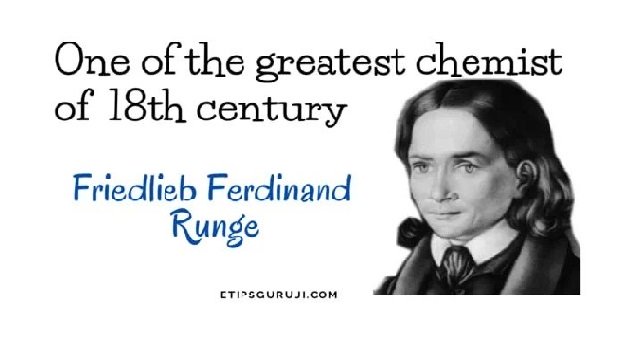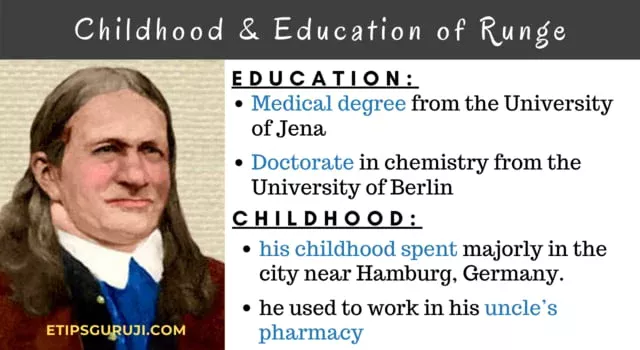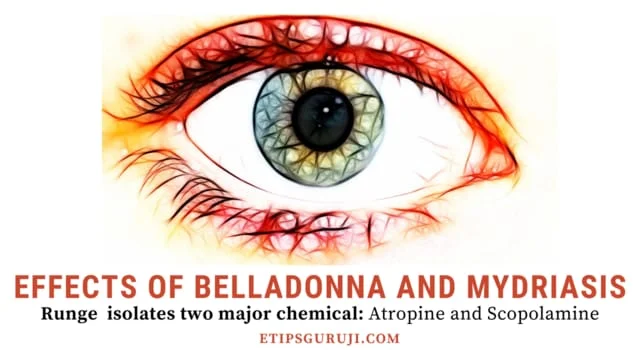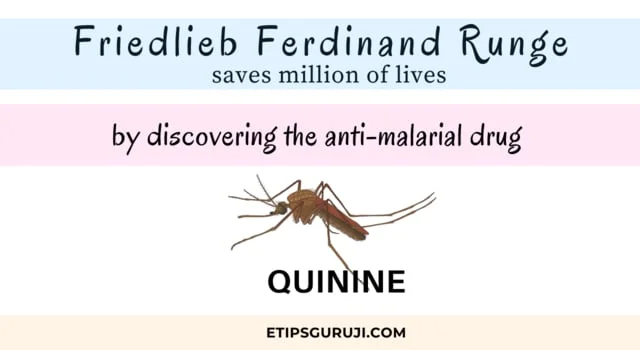Friedlieb Ferdinand Runge – Biography, Education, Discoveries & Facts

Everyone, whether you are a science student or not, had performed paper chromatography in your 9th (or 10th) grades. So, do you know, who is considered as the originator of it? The answer is, Friedlieb Ferdinand Runge. And this is precisely what this article is all about. In this post, we’re trying to give you a compressive overview of Friedlieb Ferdinand Runge’s life, schooling, career, and discoveries.
Who is Friedlieb Ferdinand Runge ?
He was a German analytical chemist who was born near Hamburg, Germany, on 8 February 1794. He took his last breath on March 25, 1867, in Oranienburg, Prussia, Germany.

Runge made many discoveries in his career, and most of them are from analytical chemistry. However, his main work deals with the application of paper chromatography
, which is not only a separating method in teaching laboratories but is also the foundation of today’s chromatographic techniques.In addition, he was the discoverer of coal tar dye, caffeine, effects of belladonna extract, and the first person to isolate quinine.
Quick Facts about Friedlieb Ferdinand Runge
- Born: 8 February 1794
- Died: 25 March 1867
- Scientific Field: Analytical Chemist
- Fellow Name: Dr. Gift
- Education:
- Medical degree from the University of Jena
- Doctorate in chemistry from the University of Berlin
- Occupation(s):
- Professor at the University of Breslau
- Chemist in a chemical factory at Oranienburg
- Major Discoveries:
- Coal-tar oil (dye)— carbolic acid (now called phenol), pyrrole, rosolic acid (aurin), and cyanol (aniline).
- Effects of belladonna and mydriasis (long-lasting dilation of the eye’s pupil).
- Isolation of Quinine— anti-malarial drug.
- Process of obtaining sugar from beet juice.
- Identification of Caffeine.
- Miscellaneous:
- Google Doodle on his 225th birthday anniversary. (Feb 8, 2019)
Childhood & Education of Friedlieb Ferdinand Runge
Runge was the third child of the pastoral family. He had a total of six brothers and sisters. And much of his childhood was majorly spent in the city near Hamburg, Germany.
In early age, he used to work in his uncle’s pharmacy where he also conducted an experiment on himself. He put some henbane juice in his eye which leads to dilated pupils (mydriasis).

While talking about his education, he completed his master’s degree from the University of Jena, Germany under the supervision of J. W. Döbereiner.
Apart from this, it was a time when everybody starts calling him “Dr. Gift”. Surprisingly, Dr. Gift in English means the person who has some gift but in german, “Gift” means poison and this was what their fellow member calls him.
He also accompanied a doctorate in chemistry from the University of Berlin in 1822.
Major Discoveries and Career of Friedlieb Ferdinand Runge
In this section, we have listed down the major discoveries that are made by Friedlieb Ferdinand Runge.
Effects of Belladonna and Mydriasis
When seeking his master’s degree, he continued the experiment that he had done on himself in his childhood— at his uncle’s pharmacy.
In his dissertation work, he formulated an experiment of belladonna (or deadly nightshade) on the cat’s eye. On the basis of the result, he concluded that Belladonna leads to prolonged dilated pupils (mydriasis).

He listed, atropine is the toxic chemical in belladonna extract that leads to mydriasis condition. In addition, Runge also proposed the working mechanism of atropine on the human body. According to him, atropine blocks the neurotransmitter— acetylcholine that is responsible for muscle movement.
However, he also discovers another component in belladonna that is also a neurotransmitter blocker— scopolamine. At that time, belladonna extract also became a trend in as a gloomy beauty among European women.
Nowadays, Scopolamine is used as an active ingredient for some anti-motion sickness drugs. On the other hand, atropine is used in eye examination and also to slow down heart rates during surgery.
Discovery of Caffeine
When Döbereiner arranged a demonstration of Runge’s work on atropine that leads to cat’s pupils dilated. A professor name, Goethe was fascinated by Runge’s research.
And at the end of the demonstration, he gave Runge a packet of coffee beans with a suggestion— their chemical components could be worth investigating.
After a year of study on coffee beans, Runge isolated the active principle (or ingredient) that nowadays, we know as caffeine. He identified caffeine as a psychoactive chemical of coffee beans that is responsible for the simulation of the central nervous system.
Interesting Facts: At that time, Runge’s extract from coffee beans was called to be “Kaffebase” but later in the 1900s, it got a new name “caffeine”.
Discovery of Coal-Tar Dye (Paper Chromatography)
Friedlieb Ferdinand Runge was a professor at the University of Breslau. But his major discoveries were when he left academics and starts working as a chemist in a chemical factory at Oranienburg.

His work on synthetic dyes led him to invent several color dyes from coal-tar oil. In his research, he isolated various components of coal-tar dye, and among all, phenol, pyrrole, rosolic acid (aurin), and cyanol are the most important isolates.
However, it took nearly 1850, to analyze all these isolates by using a pioneering technique of chromatography which was in the early phase and also the base of the paper chromatography.
So, you can say, he invented paper chromatography that has too many applications in chemistry. However, the true inventors of paper chromatography were Martin and Synge.
Hence, if you love blue dresses, give a thank to Friedlieb Ferdinand Runge. Because he was the inventor of the first coal tar dye (aniline blue) and also deduces the perfect process of dyeing clothes.
Malaria in the 14th to 18th centuries was a pandemic disease in some North-Asian countries. To treat malaria, the Quechua people of Peru and Bolivia use cinchona tree barks.

People used to have only one form of medicine available to treat malaria i.e. dried powder of cinchona, which is not that much effective as the liquid form.
With this idea, Runge started his work to isolate the chemicals from cinchona barks, and after many months of work, he was successfully able to retrieve the quinine from cinchona bark.
Hence, the discovery of quinine saves million of million life. Even now, quinine is being used as an anti-malarial drug.
Process of Extracting Sugar from Beet Juice
While tasting white table sugar, did you ever think of which plant it was made from? Many of you think— sugarcane. But beet juice can also be turned into white table sugar.
Surprisingly, you never differentiate between sugar from beet juice or by sugarcane, at least not by tasting.

And the theory of converting beet juice into sugar was proposed by Friedlieb Ferdinand Runge which is still the key process of making sugar from beet juice.
Google Tribute to Runge’s Legacy
On Friedlieb Ferdinand Runge’s 225th birthday anniversary (on 8 February 2019), Google makes a tribute to him by fabricating one of the major discoveries as a theme for Google Doodle.

The gifs (animated image) have a chemical structure of caffeine that represents the “oo” of Google. The gifs also had a man who was drinking his coffee accompanied by an owl-eyed cat.
Short Summary of Friedlieb Ferdinand Runge
Friedlieb Ferdinand Runge was an analytical chemist whose discoveries are still around today. His discoveries of alkaloids— quinine save billions of lives from now, and these numbers go on and on before, we humans extinct from earth.
In addition, the isolation of caffeine, the method of turning beet juice into sugar, and atropine as eye dilators are also important discoveries of Runge.
Nonetheless, you believe it or not, but frankly, Runge’s findings are really beneficial to humanity.
General FAQs
What did Friedlieb Ferdinand Runge do?
Ans. He was a German chemist who was a professor at the University of Breslau and later, a chemist of the chemical factory at Oranienburg.
What is Friedlieb Ferdinand Runge known for?
Ans. Runge is known for his five major discoveries— quinine, coal-tar dye, effects of Belladonna’s active principles and mydriasis, the process of converting beet juice into sugar, and caffeine.
Who influences Runge to pursue science?
Ans. There is no specific information in that context. Yet according to many believers, his uncle who owned a pharmacy has had a huge influence on Runge.
How did Friedlieb Ferdinand Runge die?
Ans. Manner of death was unknown but one known fact is he died in poverty. This is because when he became ill, the chemical company terminated his job even though he worked there for 21 years. And later, he died in poverty.

